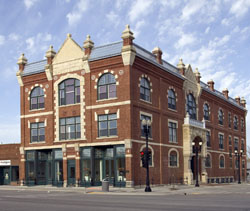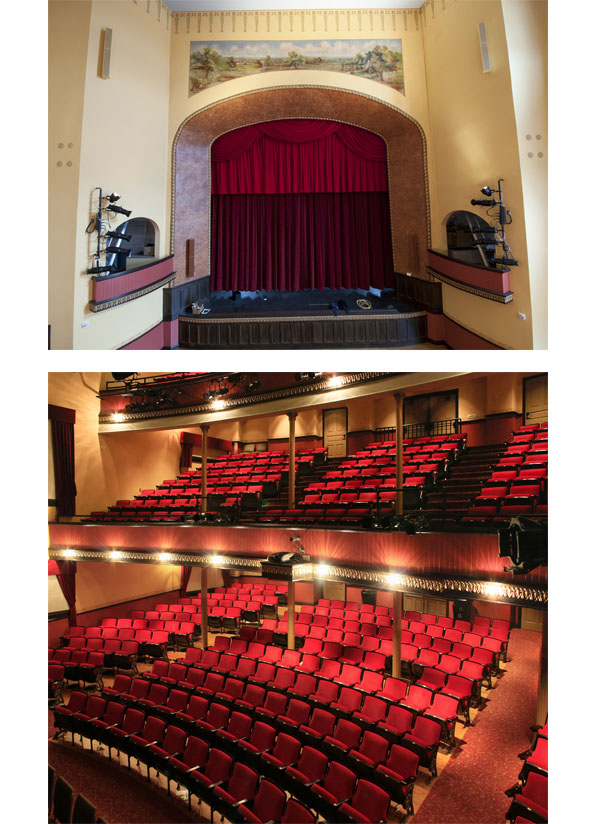
Built in 1888 and one of the most prominent buildings in downtown McPherson, Kansas, the McPherson Opera House was saved from destruction in 1986, with a comprehensive refurbishment ongoing since then culminating late last year with a new lighting rig as well as a sound reinforcement system headed by compact, digitally steerable Tannoy QFlex loudspeaker arrays.
The opera house, saved by the McPherson Opera House Preservation Company, is known for its superb acoustics and has hosted everything from Vaudeville shows and films from the golden age of cinema through to political rallies and suffrage meetings. Correspondingly, says Michael Dunn of Sounds Great Music, designer and installer on the project, “They wanted a sound system that performers would find not only adequate, but impressive” – one that would provide not only good, natural sound, but achieve a look in keeping with the buildings’ roots and legacy.
Tannoy wasn’t the first solution considered, Dunn notes. But after a closer look at the initial concept, one based around a conventional line array system, with the inherent bulk and significant architectural impact that such a system would bring to the space, the benefits of QFlex became apparent. “We started to look at the lines of sight and the 3D models the architect had, and we realized that more than half of the audience would not be covered by the traditional line array concept, and would have to be covered by additional under balcony fills.”
Beyond offering a solution that would enhance the experience of both patrons and visiting performers without detracting from the venue’s historic elegance, particularly given the very delicate and compact dimensions of the performance space, QFlex also overcame other challenges presented by the build.
Specifically, in providing clear, even coverage without forcing users to resort to thumping levels of volume. “It’s very close,” says Dunn. “The front of the balcony is about 25 feet from the stage. The farthest corner balcony seat is only 65 feet from the center of the stage.
Additionally, care had to be taken to ensure no damage was done either during the install, or during subsequent performances, to the venue’s fragile leaded glass windows, or to the plaster and lathe fresco above the proscenium – a work originally created by artist G.N Malm in 1913, and painstakingly restored by EverGreene Painting Studios and Belle Restoration from the original 1888 stencil.
Overall, the low profile, self-powered QFlex arrays are an excellent fit for the 550-seat venue’s needs. “Aesthetics were critical; equally as important as the desire for good, natural sound,” Dunn continues. “In the end QFlex made for both far less visual clutter, as well as substantial gains in terms of coverage and overall clarity.
Initially, however, those gains sounded too good to be true to the client. “When Sounds Great first proposed Tannoy’s QFlex and showed us how small they were, we were highly skeptical,” says John Holecek, Executive Director at the McPherson. “It actually created a bit of a crisis there for a minute, but you either trust your vendors or you don’t,” he adds.
In the final analysis, Holecek is glad he did. “The fact that the speakers are so unobtrusive is a huge plus in an historic theater. I can’t emphasize that enough. They blend in wonderfully well. The acoustics were always good. Now they’re magnificent.”
With both aesthetics and coverage in mind, Dunn installed one QFlex 32 on either side of the proscenium to cover the main floor and the first balcony, while another pair of QFlex 24’s – mounted above the proscenium arch – cover the second balcony.
To flesh out the bottom end Dunn specified two Tannoy Power VS 15BP subs and hung them from the second floor of the Juliet balconies to either side of the stage. “You can’t see the subs, can you?” Dunn asks, laughing. “We ported them through the wall and then sealed the ports, so that even in the Juliet balconies, while audible, they aren’t overwhelming.”
Performers will also benefit from six Tannoys V8 Dual Concentric stage monitors, chosen, again, to achieve maximum coverage with a minimal footprint.
The clarity of the system is further enhanced by key recent developments in QFlex’s digital connectivity. Ultimately that’s a product of the install coinciding with the culmination of Tannoy’s development of digital audio input cards and digital audio break in boxes for QFlex systems – The testing of which had only just been completed when the parts were shipped from Tannoy in Scotland to McPherson.
“We’re actually running to the QFlex system using AES 110 digital audio,” Dunn explains. Thus achieving even cleaner sound by maintaining the digital signal throughout the system, eliminating any additional processing and minimizing distortion. It’s the first full digital installation of QFlex in North America, and a second technological first for the McPherson, which, in its infancy, became the first ‘electrified’ venue between St. Louis and Denver.
More importantly, the full digital configuration provided an added layer of quality for the client. Always important, but even more so when doing business in a small town of 17,000 like McPherson, “where things aren’t always based on price,” Dunn says, “but on quality, close personal relationships, and whether you’re going to be here ten, fifteen, twenty years from now and still be able to service the product.”
That quality is reflected in the level of support Dunn received from Tannoy, in the care that both Dunn and Sounds Great owner Chuck Vetter took to provide the venue with the system they required, and, most critically, in the experience the Opera House has offered audiences for over 120 years.
The end result – high impact sound with a low impact visual profile across the board – Already, Holecek says that artists who’ve performed at the venue have expressed a wish to “take the theatre with them wherever they go.”

